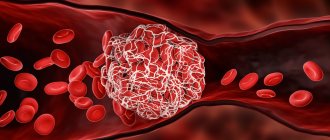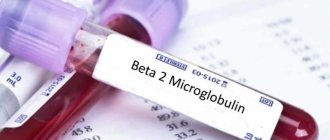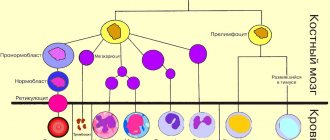Physiological role, structure and localization
Eosinophil cationic protein (ECP) is one of the proteins that make up the cytoplasmic granules of eosinophils. Eosinophils are blood cells that appear in large numbers in areas of inflammation and during certain parasitic infections. In the mature state, these leukocytes are mainly found in tissues, but about 1% of the eosinophil population circulates in the peripheral blood. Eosinophils exert their effect on surrounding tissues through four main proteins. Eosinophil granule proteins, which kill parasites and their larvae, can have a damaging effect on tissue in bronchial asthma and other inflammatory diseases. The activity of eosinophils is closely related to the occurrence and exacerbation of bronchial asthma, atopic dermatitis, rhinitis, allergic eye diseases, allergic diseases of the middle ear, parasitic and bacterial infections, autoimmune diseases, chronic fatigue syndrome. Of the four major eosinophil granule proteins, ECP (eosinophil cationic protein) is the most significant indicator for monitoring the activity of many inflammatory diseases. ECP is characterized by a high content of arginine, binding, like other “basic” proteins of eosinophils, with acidic dyes (eosin). The protein has a unique terminal amino acid sequence, which allows it to be identified using monoclonal antibodies. Absolutely specific for eosinophils. Has ribonuclease activity. Stimulates mucus secretion in the bronchi, inhibits the proliferation of T cells, binds and neutralizes heparin, inhibits coagulation, and is a powerful cytotoxin for schistosomes, causing rupture of parasite membranes and their fragmentation. ECB has a toxic effect on nerve cells, some epithelial cells and myocardial cells.
When is it appointed?
A blood test for eosinophilic cationic protein is used for the initial diagnosis of allergic manifestations, as well as to identify their exacerbations and determine the severity of the pathology. In what cases can a doctor prescribe this test?
- Complaints about the presence of typical signs of allergies: sneezing, runny nose, dry cough, lacrimation, shortness of breath. As a rule, these symptoms occur after exposure to allergens: house dust, contact with animals, flowering period, etc.
- Signs of rhinitis of allergic origin. These include a runny nose, itchy nose, nasal congestion, headache, etc.
- The appearance of food allergies: swelling and itching of the mucous membranes of the oral cavity, burning in the stomach, difficulty breathing, etc.
There are signs of atopic dermatitis: itching of the skin, the appearance of a rash on the skin, dryness and flaking of the skin, etc.
It is worth noting that an analysis for eosinophilic cationic protein can also be prescribed to predict exacerbations of allergies and monitor the treatment of allergic diseases. The test can be prescribed by a pulmonologist, dermatologist, allergist or general practitioner.
Diagnostic information
ECP enters the bloodstream during degranulation of eosinophils and reflects the severity of this process, increasing in the blood of patients with allergic diseases (bronchial asthma, allergic rhinitis, atopic dermatitis) and helminthiasis. An increase in the concentration of ECP in plasma and some other body fluids reflects the participation and activity of eosinophils in the inflammatory response. The level of ECB correlates with clinical symptoms of asthma, indicators of respiratory function (spirometry), and the response of the airways to inhalers, allowing one to assess the degree of inflammatory processes in the airways. In patients with seasonal bronchial asthma, ECP changed according to the changing activity of the disease throughout the year. ECP levels are higher than normal in both IgE-dependent and IgE-independent allergic conditions. Measurement of ECP levels is free of the inconsistencies inherent in subjective assessment of asthma. Monitoring the level of ECP in the blood allows one to assess the severity of asthma, especially in children, predict the development of an asthmatic attack, monitor the effectiveness of treatment of the inflammatory component in patients with asthma, and select the optimal dose of medications. The determination of ECP is important in assessing the severity of a number of skin allergic diseases (for example, atopic dermatitis), and its concentration correlates with the severity of a number of signs of the disease (lichenification, loss of sleep, erythema, formation of papules, etc.). In the serum of patients with atopic syndrome, the level of ECP was higher than in patients without signs of atopy, even in cases where the level of blood eosinophils remained normal. The concentration of ECP in serum can be used to judge the severity of some skin diseases. The neurotoxicity of ECP may aggravate the severity of itching in some skin diseases. Patients with papular erythematous rash have elevated levels of ECP, which normalize after the rash disappears. A relationship was shown between an increase in the level of ECP and the severity of clinical manifestations of skin allergic diseases, and its normalization during the period of clinical remission or recovery. The clinical significance of the ECP level may exceed the importance of determining total IgE, since the IgE level in some cases does not correlate with the severity of clinical symptoms.
Eosinophilic cationic protein
Eosinophil cationic protein (ECP) is one of the proteins that make up eosinophil granules. Eosinophils are immune blood cells that perform the following functions: protecting the body from parasitic infection, inactivating and preventing the long-term action of biologically active substances involved in allergic reactions. When eosinophils are activated by antibodies and cytokines, they degranulate, that is, the contents of granules, in particular ECP, are released into the bloodstream. The role of eosinophilic cationic protein in the body: 1. Preventing the degranulation of basophils and mast cells. These cells are directly involved in allergic reactions and related diseases: bronchial asthma, atopic dermatitis, allergic rhinitis, conjunctivitis, otitis media; 2. Toxic effect on the nervous system of helminths (for example, roundworms); 3. Inhibition of the reproduction (proliferation) of cancer cells; 4. Antiviral and bactericidal action. However, ECP is not harmless to the body; if it is in excess, protein side effects appear: itching of the skin, death of the bronchial epithelium, increased secretion of mucus by the bronchi, toxic effects on the myocardium. Manifestations depend on the location of the allergic reaction. The diagnostic value of determining the level of ECP lies in assessing the severity of eosinophilic inflammation. The level of ECB correlates with the severity of allergic diseases. Dynamic monitoring of the amount of ECP in the blood of patients with bronchial asthma makes it possible to predict the occurrence of an attack, assess the severity of the course, and monitor the effectiveness of treatment. ECP is considered a marker of exacerbation of allergic diseases, since the concentration of ECP increases sharply when an allergen enters the body. A special role is given to the diagnosis of allergic diseases in children, since the child’s age does not always allow one to obtain the necessary clinical data through a survey. In addition, many children's complaints are subjective. Another area of application of ECB is the diagnosis of DRESS syndrome (Drug Reaction with Eosinophilia and Systemic Symptoms). DRESS syndrome occurs due to drug intolerance and is manifested by skin rash, damage to internal organs and an increase in the number of eosinophils in the blood (eosinophilia). Most often, the syndrome occurs when taking NSAIDs, co-trimoxazole, penicillin drugs, phenytoin, phenobarbital, and sulfonylureas.
References
- Izmailovich, M.R., Gazalieva, M.A., Glushkova, N.E. et al. Eosinophilic cationic protein in patients with allergic rhinitis. Science and healthcare, 2021. - T. 22. - P. 39-47.
- Karnaushkina, M.A., Fedosenko, S.V., Danilov, R.S. et al. Eosinophilic cationic protein as a non-invasive marker of the nature of the inflammatory response in patients with chronic obstructive pulmonary disease. Bulletin of Siberian Medicine, 2021. - T. 19. - P. 59-66.
- Ostroumova, O.D., Shakhova, E.Yu., Kochetkov, A.I. Drug-induced eosinophilia. Safety and risk of pharmacotherapy, 2021. - T. 7. - No. 4. - P. 176-189.
- Bronchial asthma. Clinical guidelines, 2021. - 97 p.
- Bystrom, J., Kawa, A., Bishop-Bailey, D. Analyzing the eosinophil cationic protein—a clue to the function of the eosinophil granulocyte. Respir Res, 2011. - Vol. 12(1). - P. 10.
How to prepare
To obtain a reliable analysis result, you must follow several recommendations:
- The test must be taken on an empty stomach. At least 7-8 hours before the test, you must refuse food; you can only drink plain water without gas.
- Try not to overexert yourself physically or emotionally on the day of the test.
- A few hours before the test you should refrain from smoking.
- Tell your doctor about all medications you take on a regular basis. Some drugs may be excluded several days before the blood test.
Which blood test shows the level of eosinophils?
The exact number of eosinophils is indicated in the results of a blood test with a leukocyte formula. Blood is taken from a vein or finger for analysis. The study is carried out under a microscope using various reagents and dyes. During this analysis, the number of all types of leukocytes per unit volume of blood is calculated, as well as the percentage of each type of leukocyte. A leukogram (leukocyte formula) allows you to see the increase and decrease in the number of one or another type of leukocyte.
Why is the level of ECP in the blood determined?
ECP most accurately determines the presence of a specific inflammatory response in the body; it characterizes eosinophilic inflammation. Moreover, the more pronounced the inflammatory reaction, the higher the concentration of ECP in the blood. This indicator is considered more accurate than determining the number of eosinophils in the leukocyte formula.
Thus, by monitoring the dynamics of changes in the ECP level, the doctor can judge the effectiveness of the prescribed treatment.
ECP is studied for the diagnosis of a wide range of diseases occurring with allergy symptoms: food allergy, allergic rhinitis, atopic dermatitis, bronchial asthma, autoimmune diseases, helminthic infestation. Also, the result of the analysis allows us to assess the activity of the inflammatory process in these diseases and monitor their treatment.
What may affect the results of the study?
Please note that in some cases, eosinophil cationic protein values may be unreasonably high. For example, this can occur while taking certain medications: non-steroidal anti-inflammatory drugs, co-trimoxazole, phenobarbital, carbamazepine, sulfonylurea-based drugs (glibenclamide, glimepiride), minocycline and doxycycline, penicillin preparations. In addition, an increased concentration of eosinophilic cationic protein can occur with helminth infection, bacterial sinusitis, kidney tumors, etc. Therefore, the result of the analysis should be evaluated together with data from additional laboratory and instrumental studies.
To correctly decipher the analysis and prescribe treatment (if necessary), you need to contact your doctor. Be healthy!









